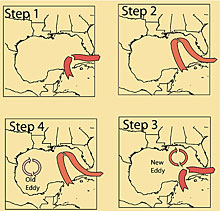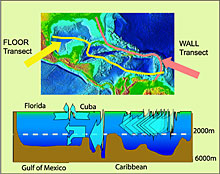
The Gulf Loop is a strong current in the eastern Gulf of Mexico. It can be a short loop (Step 1), or stretched very long (Step 2). When it is long, it often pinches off a spinning body of water called an eddy (Step 3). These eddies drift westward over many weeks (Step 4). They slowly lose energy in the western Gulf. This cycle repeats itself several times a year. Click image for a larger view.
Currents in a Cul-de-Sac
Bob Carney
Louisiana State University
We are all familiar with cul-de-sacs— neighborhoods where you have to turn you car around to get out. The circulation of the Gulf of Mexico and Caribbean is similar to a cul-de-sac. Because ocean life depends on currents to transport larvae, it is possible that the Gulf’s fauna may be controlled to some extent by these unusual current patterns.
Gulf Surface Currents
Surface currents are ocean currents in which the moving water lies between the surface and a maximum depth of about 500m. Currents that are no deeper than 200m are usually caused by the wind pushing on the water. Currents as deep as 500m usually are caused by forces associated with the rotating Earth and are called geostrophic (Earth-turned) currents. In our exploration of the Gulf of Mexico we are concentrating our research on the ecology below 500m and are very interested in the Gulf Loop, an example of geostrophic flow that strongly influences our exploration area.The Gulf Loop flows in through the straits of Yucatan and exits through the straits of Florida. Sometimes it is confined to the coast of Cuba. At other times, it flows along a long loop to the North before turning south and eventually exiting through the straits of Florida. This elongated loop is unstable and pinches off large eddies that spin clockwise as they drift westward. The eddies eventually spin down in the western Gulf. They sweep over the bottom and may have a great influence on the ecology.

The general current flow of the Gulf of Mexico and Caribbean is greatly influenced by the narrow gaps in the eastern wall and by the depth of inter-basin sills. This can be seen by examining bathymetry of two transects. Click image for larger view and expanded caption.
Gulf Deep Currents
We know little about circulation below 500m, but we are studying it extensively at this time. We do know, however, where the deep water enters the Gulf. This information leads us to suspect that animals in the Gulf may be somewhat different than those in the adjacent Atlantic.
The Gulf is rather isolated, and we know that it is 3600m deep. The Yucatan Strait is about 2000m deep, but the Florida Strait is only about 800m deep. This means that the deep water in the Gulf flows in from the Caribbean, not directly from the Atlantic. In effect, the islands of the eastern Caribbean form a very leaky wall with many shallow gaps, but only a few deep gaps. Just as this wall limits deep water flow, it might partially isolate animal populations in the deep Gulf from the populations in the larger deep Atlantic.
Researchers at Louisiana State University (LSU) (Welsh, Innoue, Wiseman, and Walker) and Texas A&M University (Nowlin) are actively studying how the deep water circulates once it enters the Gulf, and how it gets back out. So far much preliminary research has been conducted using computer simulation and a few current meters placed deep in the Gulf. In 2003, this research will be greatly advanced when many deep-sea instrument arrays will be installed by LSU, the offshore oil industry, Mexican scientists and industry, and the US Minerals Management Service. Once that operation has been completed, we will be able to determine exactly how organisms are carried by currents across the exploration area.
Dr. Susan Welsh of LSU has provided us with preliminary information about the deep currents using computer simulations and a program called the Modular Ocean Model. Her data indicate that in the expedition area of the northern Gulf, the seafloor at 500-1000m experiences average currents to the east at a mean velocity of 10 centimeters per second (cm/s). Deeper in the northern Gulf (2000m to 3000m) the currents reverse, nearly following the isobaths to the west or southwest. The mean flow along the slope is closer to 5 cm/s. Off west Florida, below 1000m, the currents flow to the north with mean currents less than 10 cm/s, increasing with depth. Eddies are spawned by the Gulf Loop eddies that are created with the general flow. Apparently, these eddies can reach bottom speeds of up to two knots. These spinning eddies move water across depths (up and down) of several hundreds of meters and may be the source for transient high velocity currents.
Sign up for the Ocean Explorer E-mail Update List.























